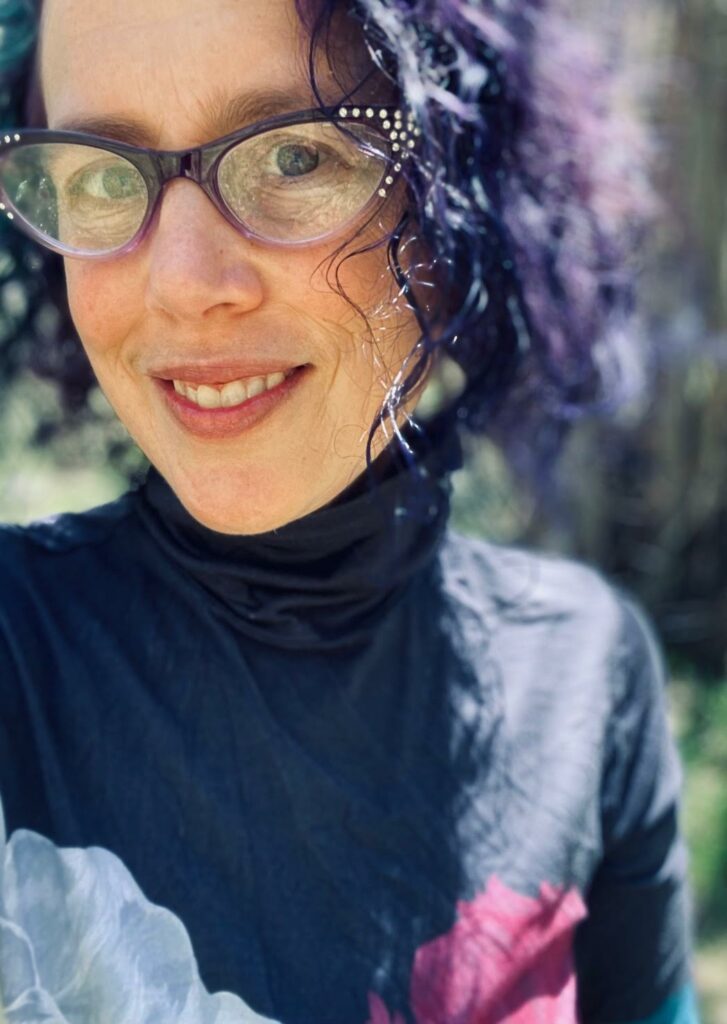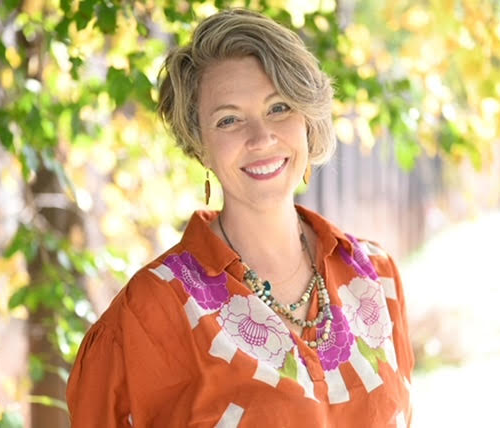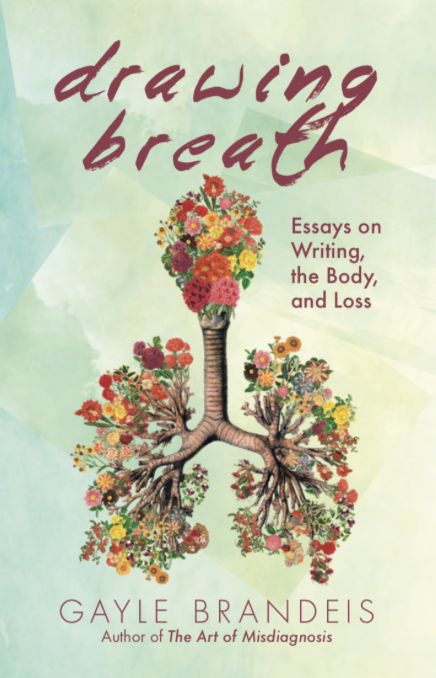Interview by Leslie Lindsay
A powerful, yet tender collection of essays grounded in the body, but giving breath to the fragments of life.
Drawing Breath: Essays on Writing, the Body, & Loss (Overcup Press, Feb. 2023), “is a one-of-kind pastiche: survey results, film transcription, the history of a perfume, and exploration of the choral voice, an interview with the self,” (Maggie Smith, author of Goldenrod).
Gayle Brandeis’s essay collection invites readers into a personal, but also universal worldview. Throughout this compassionate and generous collection, we delve into so many things that haunt and drive not just Brandeis, but humanity: body issues, the shaming of own minds, the world at large, long-haul COVID, marriage, and aging parents. Brandeis, an author and poet, based in her home city of Chicago, following a decades-long foray to the West Coast, explores the potent intersection between writing and breath, cataloging life’s ups and downs in what might at once appear to be an essay collection, but in a sense, offers a more in-depth portrait of the author.
What might have begun as an exploration of the pandemic, Drawing Breath is anything but a ‘covid book.’ It’s a collection of experiences, observations, and as Brandeis writes, “shaped by the tides and grit of my life,” which is very poetic—and accurate—way of describing this work.
The thru-lines in Gayle’s work, as a whole, for those who have read her other work, but specifically, this collection, is grief, mental illness, health, motherhood, curiosity, and devotion, which, quite possibility, may be translated to ‘love.’
Drawing Breath is a love letter, in a sense, to those who have been shaped by and through her life, but also a love letter to the world. It’s about picking up those shells, rocks, coins, and books, inspecting them, laying them bare, and then reevaluating them. It’s about finding resonances and hearing them ‘speak’ to one another, because everything we obsess on comes full circle. Everything thing we breathe becomes us, becomes the world, the land.
Brandeis takes us on a journey through time, into her homes, her marriage(s), her mother’s suicide, her son’s birth. She shines a light in the dark, a spark of levity into a weary world. She lets us breathe.

Gayle Brandeis
Leslie Lindsay: Gayle, I am so taken with this collection, it really speaks to my writer’s heart, but also to my mother heart, my nurse heart, and so much more. You start Drawing Breath by writing about your collections as a child, how you tenderly lined up tiny things—jewelry, erasers, shells—and then rearranged them. I love this analogy. As writers, I believe we are always aligning: observations, experiences, letters, words. I want to capitalize on two words here: ‘tiny’ and ‘collection.’ Each of these speaks to the entirety of the whole. Would you agree that Drawing Breath is about small slices of life expanded?
Gayle Brandeis: “Small slices of life expanded” is such a beautiful way to describe the collection, one that helps me see my own work in a fresh way—thank you for that, and for all your generous words! Your wonderful phrase makes me think of when I was a senior in high school, and my philosophy teacher led us through a mindfulness exercise with a strawberry—she had us take five minutes to explore the strawberry with all our senses but taste, then take five minutes to eat the fruit slowly, with intention; I had never paid such close attention to a strawberry before, and the experience blew me wide open (in fact, the first line of my book Fruitflesh: Seeds of Inspiration for Women Who Write is “A strawberry changed my life,” and shares that formative experience.)
The strawberry meditation showed me that if you slow down enough and let your senses take things in deeply, you can experience and learn so much on a level that feels both granular and expansive—a small slice of life expanded, for sure. I try to do this with my essays, too, slow down and unpack an experience or idea in a way that feels both granular and expansive. Writing helps me “taste life twice,” as Anais Nin says, and I love to find new flavors and textures and other buried treasure the second time around.
LL: I want to talk about the title essay for a bit because I think it is the pinnacle of the entire collection, the connection between writing and the breath, how breath forms our voice, and our voice forms—and informs—what and how we write. But there’s more here, too.
The process of inhalation is actually ‘inspiration,’ and the process of exhalation is ‘expiration,’ and this is so integral to the creative process. Moreso, this essay is formatted and stylized to mimic the shape of breath, the doming of rib cage, the diaphragm. It’s a delightful and smart play on words, and shape. Can you talk a little about how this piece came together?
GB:I wrote the title essay over 20 years ago, as my critical paper when I was getting my MFA at Antioch University, and love that it still has so much life inside of it. I’m on the faculty at Antioch now; a lot of my students are afraid of the critical paper requirement, and I tell them it’s a great opportunity to explore subjects they’re passionate about, subjects that are deeply meaningful to them (and who knows? Their paper may end up as the title essay in their essay collection a couple of decades down the line!) I chose to explore this topic because I had been curious about and fascinated by the connection between writing and the body for many years at that point, and found the breath provided a really powerful bridge between the two—breath is written into our punctuation, into our grammar, into the poetic line, into, as you noted, the word “inspiration” itself.
I chose to divide the essay into “Inhales,” where I looked inward, toward my own experience with breath, and “Exhales,” where I delved outwardly into research and analysis about the connection between breath and writing, a back and forth structure that mirrored my own relationship with writing, breathing the world in, then breathing my own perspective and experience out.
I can’t take credit for the beautiful shapes on the page—Jenny Kimura (who does book design for Little, Brown, as well as for Overcup Press, who published my book) came up with the brilliant idea of creating a visual representation of breath on the page, contracting and expanding the text itself. I’m so grateful for how she took my idea to the next level, helped it become even more fully itself.
LL: You write quite a bit, too, about the body in a more general sense. How it’s at once amazing and elastic (your love of ice skating; giving birth), but also how it can be a source of shame (‘thunder thighs,’), and this was something I found myself nodding in recognition with. I had no idea so many women had such a loathing relationship to their thighs. The way you presented this information—in a survey result—I found so creative. In a sense, would you say Drawing Breath is a bit of a hermit crab essay collection? Did you find it liberating to play with form?
GB: I utterly love the hermit crab form, both reading it and writing it, and definitely mess around with that and other forms within this collection, though not with every essay. I suppose you could call the collection a hermit crab as a whole, since it’s structured around different types of breath, though I reversely engineered the structure, finding a form I could drape over an already-written collection rather than writing a collection to fit a chosen form. I do find playing with form can be liberating, sometimes, paradoxically, because of its constraint.
I was part of an experimental performance group in college, and the director would give us “scores”—little beats we needed to hit, that would structure what was otherwise pure improvisation…for instance, I remember one piece, where the score was “If someone touches your shoulder, stand still and turn your head to the left.” This provided little touchstones for both us as performers and for the audience, little moments of stillness and breath in the middle of all the chaotic movement; it was this constraint that gave the chaos meaning and shape, and helped us feel free to go wild between those moments.
Perhaps that’s not a direct parallel with writing with form, but I do feel a resonance there. Form can also be comforting, as Brenda Miller and Suzanne Paola suggested when they first introduced the term “hermit crab”—it can offer a safe place to pour a vulnerable story, just as a vulnerable little hermit crab finds a new shell or can or other suitable object to protect itself, an object that will become its home. I love finding the right form for a story, whether it’s a traditional narrative structure or something more experimental; it’s so satisfying when form and content dovetail and find home within each other.
“I love finding the right form for a story, whether it’s a traditional narrative structure or something more experimental; it’s so satisfying when form and content dovetail and find home within each other. ” — Gayle Brandeis
LL: Like you, my mother also suffered from severe mental illness/delusions and died by suicide in 2015. You write so eloquently about this experience and I love, love the ‘self-interview with author’ in this collection. Can you summarize this piece a bit for us? Again, it’s presented in a unique form, which I appreciate, but also offers some deep insights about such a powerful and troublesome experience. How did writing your memoir [The Art of Misdiagnosis] change you?
GB: This is a hard club to be part of, one I would never wish on anyone, and while I’m so sorry you’re part of it, I’m also so grateful we can shed light for one another. Thank you for your support and solidarity; it means so much. This piece came about because The Nervous Breakdown, a journal I love, has a great “Self Interview” section, and they asked me to interview myself to mark the release of The Art of Misdiagnosis.
I had felt utterly transformed by the writing of my memoir in some ways, and not changed at all in others, so I decided to ask myself the question “How did writing your memoir change you?” over and over again to see how many different ways I could answer the same question. A lot, it turned out, and some of the answers were contradictory, since I (like Whitman and all of us) contain multitudes.
Writing my memoir helped me see I had more courage than I realized, and it helped me find compassion for my mom, helped me appreciate her in a way I hadn’t when she was alive. That in itself was so healing and transformative. The book wasn’t a silver bullet of healing, though—I had let myself think it would be, and I was shocked when that complicated grief still lived inside me, shocked that I’d still feel the need to write about her after I thought I’d already left it all on the page. Writing the memoir offered a deeply important means of grappling with her death and our relationship, but the grappling continues, as does the grief, as does the healing.
LL: Your father, too, is in these pages with his ‘Room 205,’ which was coincidentally the same room number he had at various apartments and assisted living facilities until his death. You write about hidden places and hidden truths, and I am wondering if this somehow circles back to this idea of ‘tiny’ and ‘collection.’ What exactly, would you say, we are ‘collecting’ in this life?
GB: What an evocative question! We’re collecting so much all the time—a rush of sensory impressions, of experiences, of connections, that all get distilled by our bodies and minds and logged as memories, as meaning. These inner collections/recollections are much more profound and ephemeral than the concrete objects we leave behind when we die (as deeply meaningful as those concrete objects can be) and they die with us, unless we capture them through writing or other means of storytelling or art making.
I’ve been doing some genealogical research—I know you’ve been, as well—and I so wish my ancestors had left more of a record of all they’d collected within themselves, all they’d noticed and worried about and loved. Of course, we hold our ancestors in our genes, so we’re literally housing their collections inside our bodies, though not always in ways that are easy for us to translate or understand.
LL: Ultimately, I think Drawing Breath is about love, but grief. Can one have one without the other? Are they different sides of the same coin? Must one have grief to be able to understand—accept—the love?
GB: Grief and love are deeply interconnected, for sure, and are both so central to this collection. Grief becomes a new manifestation of love after someone is gone (or sometimes when someone is still here but declining.) I don’t know if we need to have grief to be able to understand and accept love, but grief definitely can help us understand love in a fresh way, can help us examine new angles of the beloved person we lost and inspire us to carry their light forward or choose a different path.
LL: I want to end with one of the last essays in this collection and that is ‘A Mourner’s Guide to Home Renovation,’ which I really relate to—mostly, because I believe our homes are such an embodiment of ourselves. Maybe because I feel our home is a body. Can you expand on that?
GB: A home is definitely a body, one that holds us and cares for us, and one that we care for in turn—a mutualistic relationship, like the birds that hang out on rhinos and eat the ticks from their skin, to the benefit of both (well, maybe not exactly like that!) We’re still getting to know our new house, and it’s kind of like getting to know any new body—it’s full of surprises—some delightful, others not. I actually just got a lovely text from the previous owner, giving us some info about the 1950s plumbing, and tips to keep the pipes from freezing, and I so appreciate they took the time to share this with us, to help us know how to care for the body of the home they lived in and loved for nearly 40 years.
We’ve been finding ways to make the house our own, and will continue to make it all the more so as we continue to settle in, but I can also feel the history of the place, how it’s had a big life before us, how it’s held so many bodies, so many lives, and how it will likely hold so many more after we’re gone. I was super aware of this when I was renovating the house in the essay, too—I knew I changing the creative decisions others had made as I put my own stamp on it, and knew others would later change my creative decisions to make the place their own. It’s an interesting mix, feeling embraced by a home but also knowing the house will have a life beyond me. I guess that’s the same with everything in this life, though—we’re all so fleeting in the big scheme of things, but while we’re here, we can create beauty and comfort for one another.
Gayle Brandeis is the author most recently of the novel in poems Many Restless Concerns (Black Lawrence Press), shortlisted for the Shirley Jackson Award, and the memoir The Art of Misdiagnosis (Beacon Press), as well as several novels, a poetry collection, and a writing guide. Her essay collection Drawing/Breath will be released by Overcup Press in 2023. Her work has appeared in The New York Times, Washington Post, Salon, and more. Awards include the PEN/Bellwether Prize and the Columbia Journal Nonfiction Prize. She teaches in the MFA programs at Sierra Nevada University and Antioch University.

Leslie Lindsay
Staff InterviewerLeslie A. Lindsay is the author of Speaking of Apraxia: A Parents’ Guide to Childhood Apraxia of Speech (Woodbine House, 2021 and PRH Audio, 2022). She has contributed to the anthology, BECOMING REAL: Women Reclaim the Power of the Imagined Through Speculative Nonfiction (Pact Press/Regal House, October 2024).
Leslie’s essays, reviews, poetry, photography, and interviews have appeared in The Millions, DIAGRAM, The Rumpus, LitHub, and On the Seawall, among others. She holds a BSN from the University of Missouri-Columbia, is a former Mayo Clinic child/adolescent psychiatric R.N., an alumna of Kenyon Writer’s Workshop. Her work has been supported by Ragdale and Vermont Studio Center and nominated for Best American Short Fiction.



